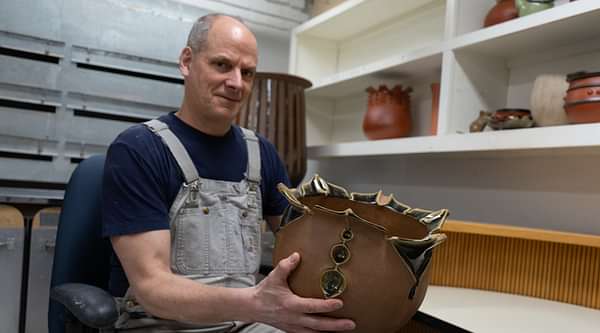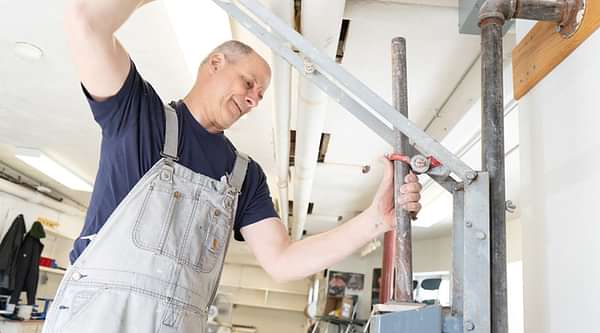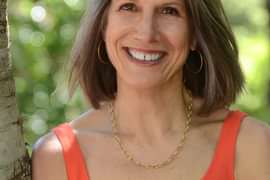
March 18, 2019
Behind the wheel
Art instructor Thayer Zaeder ’83 talks about pottery and his Andover experienceby Kristin Bair O’Keeffe
Thayer Zaeder ’83 is a faculty member whose long, rich history with PA began in 1978 when his parents, Sylvia L. Thayer ’54 and J. Philip Zaeder, moved to campus. Philip was the Protestant chaplain and an English teacher; Sylvia, a cluster dean.
Growing up on campus as a “faculty brat” and then graduating from Andover, one might conclude that Zaeder would have wanted a life away from PA. Not so. After graduating from the University of the Arts in Philadelphia, Zaeder studied ceramics in South Korea, pursued an MFA, and worked as a ceramic artist in Seattle, Wash. But Andover beckoned and in 1999 he joined the faculty as a full-time art instructor. Zaeder has served in nearly every PA role imaginable, but the one he cherishes the most is teacher.
You’ve been a PA faculty child, student, teacher, house counselor, cycling coach, parent, uncle, and, department chair. How do these roles inform your work?
That’s a good question. Almost an identity question. Because I’ve been so enmeshed in the school in so many different ways over the course of my life, it’s a little hard to unpack.
Let’s start with ceramics. How did that interest begin?
In 1980, I was a lower here at Andover and took my first ceramics class with Audrey Bensley in the very building that I now have taught in for 20 years. It was a perfect fit with my personality. I was a shy kid. I didn’t need a lot of social interaction. I was a visual thinker and I liked working with my hands.
Did you know all this about yourself back then?
Probably no more than any teenager knows him or herself. It just felt like a place that I could be myself.
Did your parents ever question your choice to become an artist?
My parents were very supportive, always, of my interest in the arts. I feel really blessed that they said, “If that’s what you’re passionate about, go do it and hopefully the cards will fall in place.” And they have.
What was the first piece of ceramics that moved you?
My earliest memory of looking at form was through Audrey Bensley’s guidance. In her office at Benner House, Audrey kept 25 or 30 years of her work and student work, a crazy mixture of her experiments and good student ideas. She tolerated chaos, in fact she let it inspire her. I don’t remember a particular piece, but I remember wandering in that office, which she kept open during class. Everything was dusty and dirty with things piled everywhere. It wasn’t well organized. That wasn’t Audrey’s thing. But it was full of great ideas

I’m of a generation where not knowing was more a part of one’s lived experience, whereas students today are much more uncomfortable with uncertainty.
”What inspires you?
The arc of one’s creative process is long. When I look back at some of the things I made even five years ago, I think, I’ve moved on from that. I’m not sure that I’m any better than I used to be, but my interests have shifted. Audrey passed away just last year. After her memorial service in Cochran Chapel, her family did a wonderful show of her pots in the Underwood Room. I know her work well, obviously, but I looked at her pots on that day and noticed they were all different, every single one. Audrey was experimental. She always had to try something different. That inspired me to take more chances with my work.
What do students get from working with clay?
Clay has a grounding quality to it. Because it’s kinesthetic, it forces students to slow down. Nine times out of 10, I see students visibly relax when they start working in the studio. For them, in that moment, other stuff drops away.
How do students handle the risk and failure inherent in ceramics?
With hand-building, which is what I predominantly teach, there’s less failure than when working on a potter’s wheel. Things rarely collapse. But there still is something valuable in having to be uncertain. I’m of a generation where not knowing was more a part of one’s lived experience, whereas students today are much more uncomfortable with uncertainty. They can get answers so much quicker than I could.
Happiest moment at Andover?
Seeing my son graduate was a very fulfilling moment. He had such an unbelievably positive experience here. Not that I didn’t, but he’s a different kind of person than I am. He was a Blue Key Head, and he was all in. He loved this school, his courses, and his teachers.
Most challenging moment as a teacher?
My first few years as a new teacher here at PA were tough. I wasn’t very good at the craft of teaching. I was not in tune with the student experience and I was over-teaching. My teaching changed a lot once I became a house counselor and realized how much work is really on a kid’s plate.
 Thayer working in Benner House
Thayer working in Benner House
Besides a lot of exercise, what do you get out of coaching the cycling team?
It’s a classroom, just a different classroom, and I enjoy interacting with students, particularly since I’ve left the dorm. It’s also unique to cycling, and maybe cross-country, where the coaches actually train with the athletes because we have to keep up with them. We have to supervise them. We can’t be on a moped with a bullhorn. Because of that, the bond is even closer.
Favorite place on campus?
The artist in me is most drawn to all of the vistas, especially The Elm Arch and the quads. When I ride my bike along the paths, the symmetry of the place is amazing.
You get to invite three Andover people to a dinner party. Who do you invite and why?
Ted Sizer, because of his experience in educational institutions. He had a wonderful way of thinking about schools. Audrey Bensley, of course. She was such a character and was never one to mince words. And Becky Sykes is a classic Andover person. Becky would keep things flowing.
Photos by Jessie Wallner
Other Stories

New Charter and Alumni Trustees begin terms July 1




